Rethinking the Airless Bodies
Abstract
While the group of rocky, airless bodies includes objects that are still being discovered, it also includes objects that have been known since humanity first turned its gaze upward. The Moon was a natural target for the first robotic and human explorers to break free of Earth's gravity, and the first spacecraft to study Phobos and Deimos did so in tandem with early visits to Mars. The first reconnaissance of Mercury occurred only months after the first visit to Jupiter, and years before the rest of the outer solar system was visited by spacecraft. As a result, theories and models about the origin and evolution of these bodies, informed by spacecraft data and occasionally surface samples, have been circulating for decades. Similarly, while the first flybys of asteroids did not occur until the early 1990s, they reinforced some preexisting expectations along with delivering surprises. A renaissance of planetary exploration in the past decade has led to a wealth of new data and reevaluations of our understanding. The new measurements and observations, combined with the availability of more sophisticated simulations of orbital dynamics and surface evolution, show instead that these analogies are not as strong as once thought or are superficial—there is a wide variety in small body compositions and geology; Mercury is far from being a twin of the Moon. Furthermore, their histories are full of active processes, from gravitational and nongravitational forces drastically changing asteroidal orbits and spins to the unceasing rain of solar wind protons changing surface spectral properties to volatiles hopping across their surfaces before finding a cold place to stick.
Keywords
Airless bodies; Exploration; Rocky; Phobos; Deimos; Asteroids; Moon; Mercury
While the group of rocky, airless bodies includes objects that are still being discovered, it also includes objects that have been known since humanity first turned its gaze upward. The Moon was a natural target for the first robotic and human explorers to break free of Earth's gravity, and the first spacecraft to study Phobos and Deimos did so in tandem with early visits to Mars. The first reconnaissance of Mercury occurred only months after the first visit to Jupiter, and years before the rest of the outer solar system was visited by spacecraft. As a result, theories and models about the origin and evolution of these bodies, informed by spacecraft data and occasionally surface samples, have been circulating for decades. Similarly, while the first flybys of asteroids did not occur until the early 1990s, they reinforced some preexisting expectations along with delivering surprises.
In this chapter, we cover a history of exploration of the airless bodies and review the key observations and discoveries that led to the paradigms that were in place at the start of the 21st century, followed by the recent discoveries that challenge many of those paradigms.
Early History of the Exploration of Rocky Airless Bodies
Exploration of the Moon Prior to the 1990s
While spacecraft and telescopes have returned priceless data, the naked eye was the first tool used to understand our planetary neighbors. The ancients knew the Moon had lighter and darker regions, though few sketches remain (Fig. 3.1). They also knew of Mercury, though only as a “wandering star.” Telescopic measurements of heavenly bodies began in the 1600s, and the current-day names of many lunar features (including its “seas” or mare) date from this period.
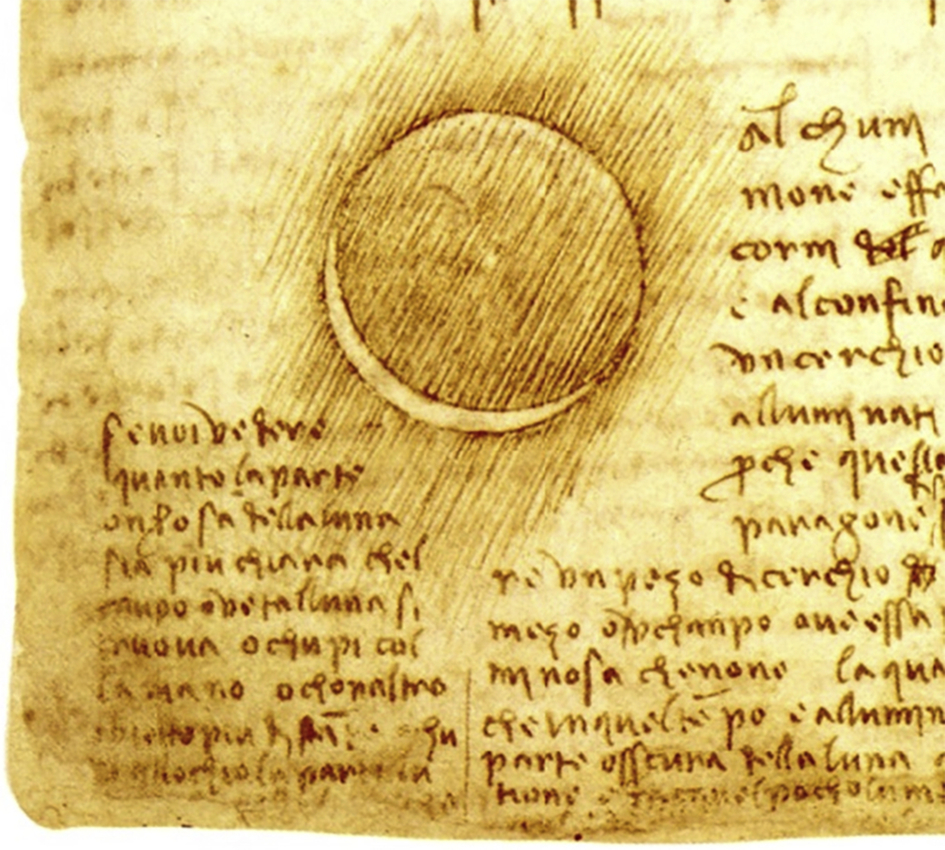
The Moon was the first extraterrestrial object to be explored, and it is the planetary object we know best besides the Earth. Much lunar exploration was done in preparation for and in conjunction with bringing humans to the Moon, but lunar exploration predated any stated plans for human exploration and has continued in the post-Apollo era.
The Moon was first mapped by astronomers using eyepieces and sketching what they saw. By the mid-1800s, it was known that the Moon had no atmosphere and suspected by some that craters were caused by meteorite strikes. The publication of a large volume of lunar maps by Beer and Mädler in the 1830s established that there were no expanses of water in the lunar “seas.” The development of photography allowed more quantitative measurements of lunar properties, and in the first few decades of the 20th century it was recognized that the Moon reflected < 10% of the light that fell on it, similar to volcanic earth rocks. However, the nature of lunar craters was a matter of ongoing controversy as some favored a volcanic origin and others favored an impact origin.
The early exploration of the Moon by spacecraft was filled with unsuccessful attempts. The first seven attempts to send a spacecraft to the Moon, spanning a period from August to December 1958, ended in failure before the Soviet Union's Luna 1 flew past the Moon in early 1959 (Fig. 3.2). Over the next decade, increasingly sophisticated impactors, landers, and orbiters explored our nearest neighbor in support of efforts by the United States and Soviet Union to land humans on the Moon and return them safely1, a feat involving almost unimaginably rapid advances in technology, engineering, and science. The story of the Apollo program has been told repeatedly, but it was a watershed in planetary science whose returned samples and data collection enabled a revolution in our understanding of not just the Moon but other airless bodies, and indeed the solar system as a whole. Through the Apollo program, 380 kg of lunar samples were returned to Earth from six different sites between 1969 and 1972. These were augmented by an additional 300 g of material returned from three Soviet robotic missions from 1970 to 1976. With the return of Luna 24 in 1976, the initial period of lunar exploration closed for nearly 20 years.
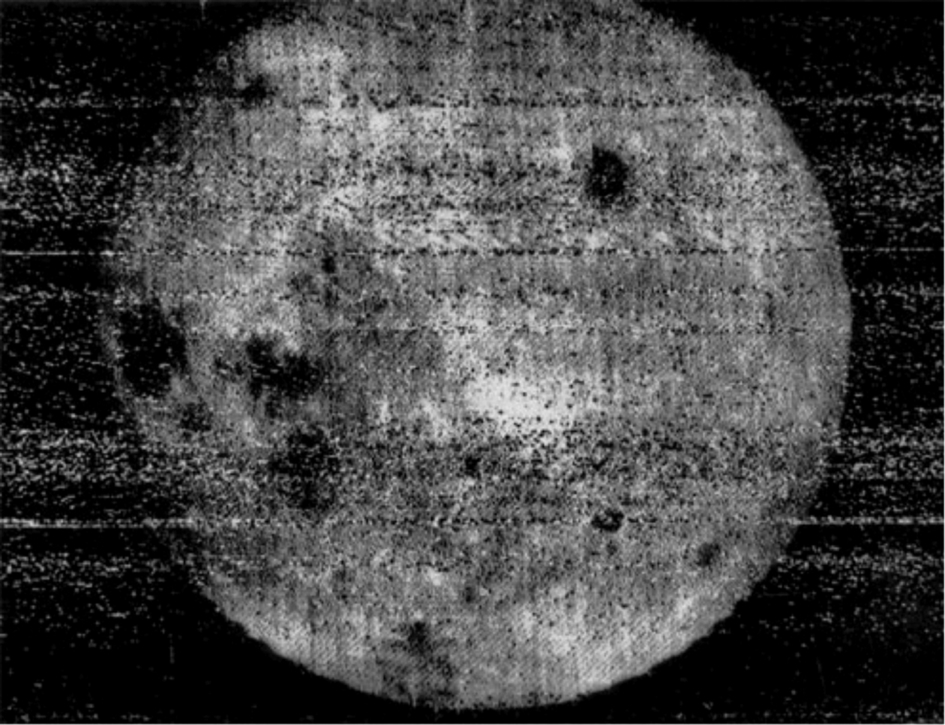
Early Exploration of Phobos and Deimos
At the time humankind was first setting foot on the Moon, we were also reaching out to the other planets with robotic spacecraft. Our first good looks at Phobos and Deimos came from the Mariner 9 mission, which arrived at Mars in 1971 between visits to the Moon by Apollo 15 and 16. Observations of Phobos and Deimos were not considered high priority for Mariner 9, and were only obtained because a global dust storm made observations of Mars of dubious utility. The ambitious Viking program sent two landers and two orbiters to Mars in 1976. While the landers did not make measurements of the Martian satellites, the orbiters provided most of the information available for Phobos and Deimos until the 21st century. Our knowledge of these bodies would have been tremendously advanced by the Soviet Phobos 1 and Phobos 2 missions of the late 1980s, which were designed to place a hopper and landers on Phobos to measure its composition. Unfortunately, these missions failed2, as did the later Russian Phobos-Grunt mission designed to return samples of Phobos to Earth. As a result, our knowledge of Phobos and Deimos is restricted to imaging, spectroscopy, masses, and volumes, determined from spacecraft on Mars and in its orbit, and Earth-based telescopes.
Early Exploration of Mercury
Telescopic observations of Mercury have been made since the middle of the 1600s, when the phases of Mercury were first seen. Its proximity to the Sun made observations difficult and led many astronomers to erroneous conclusions, including the existence of clouds and a 24-h rotation period. However, by 1835, Mercury's size was known within 30 km and a close pass of comet Encke to Mercury allowed its mass to be measured within 30% of today's accepted value (Fig. 3.3). Polarimetric measurements in the 1920s by Lyot showed Mercury to be similar to the Moon, setting an expectation that lasted through the Mariner 10 flybys of the 1970s and until the MESSENGER flybys in 2008/2009. The last major prespacecraft finding in Mercury science was a measurement of its rotation period using radar in 1965, which established its rotation period was 59 days, in a 3:2 spin-orbit resonance with the Sun rather than in a 1:1 spin-orbit resonance with a period of 88 days as was thought prior to the radar measurement. Mariner 10 was the first spacecraft to encounter Mercury, making three flybys in the period of 1974–75. The spacecraft carried a television photography camera, infrared radiometer, UV spectrometers, plasma detectors, charged particle telescopes, and magnetometers. Because of the trajectory necessary to reach Mercury and due to its curious spin-orbit resonance, despite these repeated flybys, only 45% of the surface was observed by Mariner 10. Missions to follow up Mariner 10’s visit were occasionally proposed by scientists, but the next big step in our understanding did not occur until the MESSENGER mission had three flybys of Mercury during 2008–09, and orbited it from 2011 to 2015.
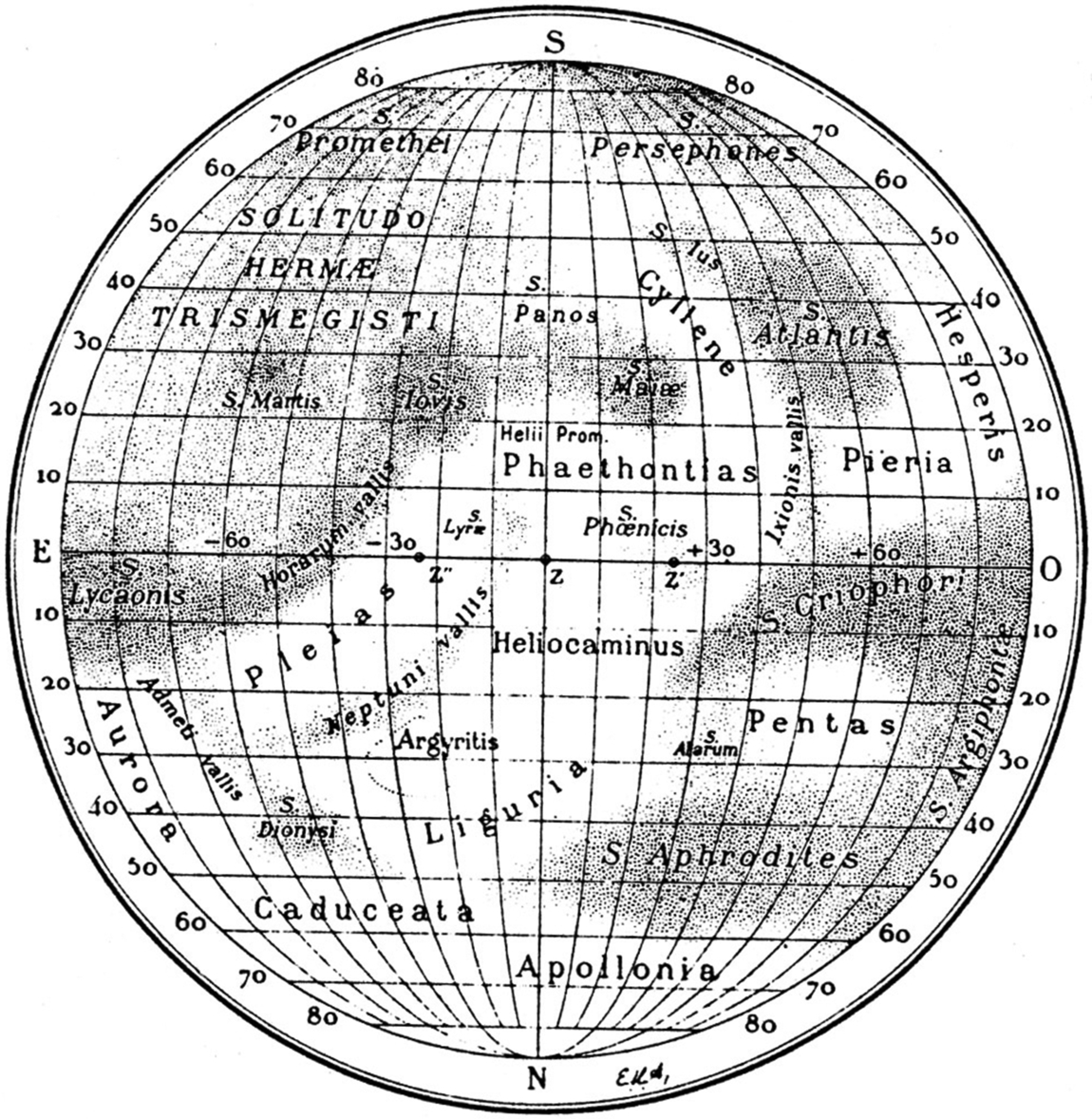
Early Exploration of Asteroids
Our understanding of asteroids prior to the 1990s was entirely generated from telescopic measurements, inferences from meteorite samples, dynamical simulations, and analogies to better-explored objects like Phobos, Deimos, and the Moon. The Galileo spacecraft encountered two asteroids en route to Jupiter: (951) Gaspra (Fig. 3.4) and (243) Ida, demonstrating that space weathering occurs on asteroidal surfaces, providing suggestive evidence that the most common inner-belt asteroids are related to the meteorite group most commonly seen to fall to Earth, and discovering the first-known asteroid satellite, Dactyl, around Ida.
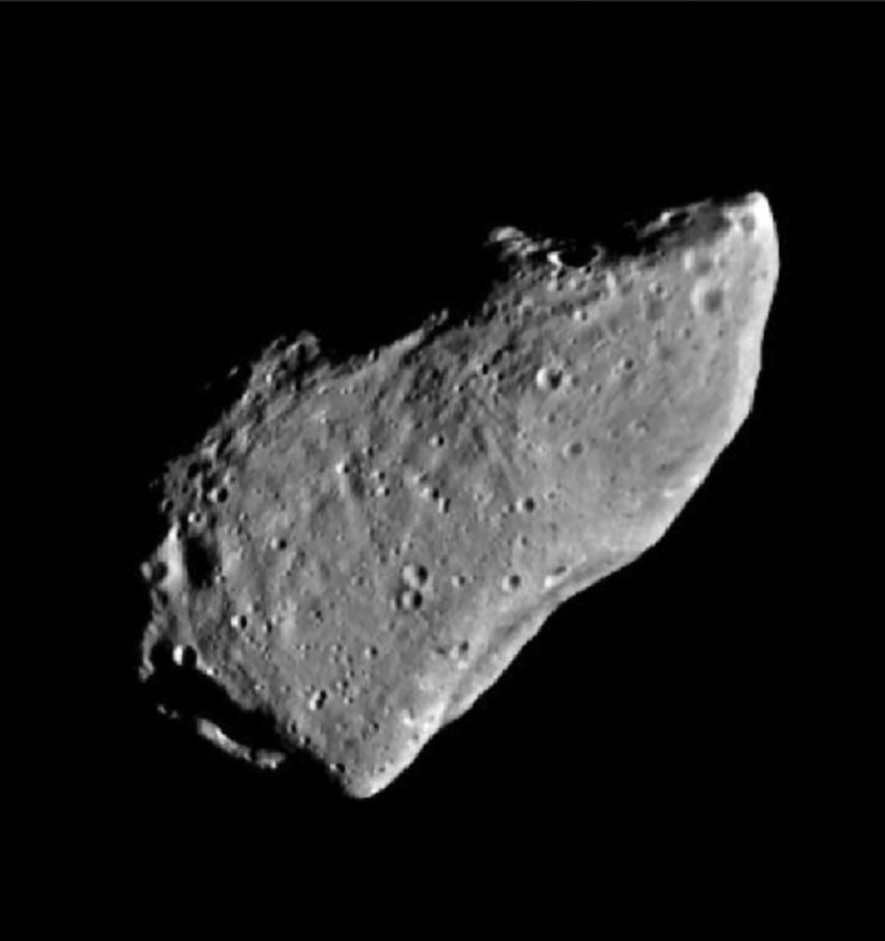
Our Changing Paradigms
At of the turn of the 21st century, paradigms were in place for the surfaces of airless bodies, built from several spacecraft encounters and decades (or longer) of telescopic observations. For each object or population, however, additional measurements showed that many of these paradigms were wrong or incomplete in ways we have only recently been able to fully recognize.
Formation of the Solar System
Over most of the history of planetary science, our understanding of the solar system was that as a general rule, objects on stable orbits were near their formation locations. This understanding has been upset by a new understanding that a period or periods of giant planet migration and movement early in solar system history likely led to large-scale changes in its architecture. In 1993, Malhotra first demonstrated that the orbits of the transneptunian population showed evidence of giant planet migration. The two main phases of planetary migration in early solar system history are generally called The Grand Tack and The Nice Model Phase, the latter named for the city in France rather than for its aesthetic properties.
The Additional Reading section includes more detailed works about The Grand Tack and The Nice Model, but their implications are that the low-albedo, organic- and water-rich asteroids now dominating the main asteroid belt may have formed among the giant planets and been later transported to their current orbits interior to Jupiter, and indeed that even material that formed near 2–3 AU may have been moved away from that solar distance for a time before returning. Because some theoretical work suggests that ice may have been unstable at the conditions experienced by the inner planets when they were forming, delivery of water and organics during a period of large-scale transport could explain why we have water on Earth today. Additional dynamical studies suggest that the asteroid belt once stretched closer to the Sun, though most of that extension has since been removed due to resonances that were established when the giant planets reached their final orbits. Evidence for large-scale mixing of inner and outer solar system material was found in the sample returned by Stardust in 2006 from the coma of Comet Wild 2, but it is not clear whether that mixing predated the Grand Tack era.
The Moon
Over the decades between the close of the Apollo and Luna programs and the renewed interest in lunar missions represented by Clementine, Lunar Prospector, and their successors, lunar science reached a point where many major questions seemed to be settled. It was generally accepted that the Moon was one of the most anhydrous, volatile-free objects in the solar system. The samples returned by Apollo and Luna showed varying levels of maturity, thought to be due to an increase in glass and agglutinate formation with increased exposure to micrometeorites. These samples also allowed an absolute time-stratigraphic system to be established for the Moon, limited by the confidence with which particular samples could be associated with particular craters or basins and the confidence with which precise dates could be determined. While the geochemistry of the returned lunar samples did not agree with any of the proposed origins of the Moon that had been considered at the time, later theoretical developments pointed to the Moon forming in the aftermath of an impact between the Earth and a Mars-sized object. The “Giant Impact Theory” remains in favor today.
In the last decade, we have learned a great deal more about the Moon through continued study of the returned samples and new data. A new generation of orbiters, particularly the Lunar Reconnaissance Orbiter, has provided complete imaging coverage of the lunar surface at wavelengths spanning the ultraviolet to midinfrared and including radar and elemental measurements (Chapter 4). India's Chandrayaan-1 spacecraft contributed infrared data critical to the discovery of hydroxyl on the lunar surface, while Japan's Kaguya returned HD-quality movies from lunar orbit and China's Chang’E 3 was the first lunar lander since the 1970s. In addition, over 200 lunar meteorites totaling over 100 kg of mass have been identified, representing over 100 distinct samples of up to 10 kg per stone. While these meteorites have been weathered after spending time exposed to the terrestrial atmosphere and hydrosphere, they come from parts of the Moon unvisited by astronauts or sample return spacecraft, including samples likely from the far side of the Moon. As a result, they significantly broaden our understanding of the Moon.
Water on the Moon
Perhaps the most significant update to our understanding is a revised estimate of the volatile inventory of the Moon, particularly its water. The samples returned from the Moon during the Apollo era were exceedingly dry, drier than the most arid of Earth's deserts. There was no indication that any water had ever altered these samples, and hints to the contrary were interpreted as reactions with and contamination by the Earth's atmosphere. Finding water on the Moon was considered highly unlikely. However, it was known since the 1960s that there might be cold, dark places on the moon that could play host to volatiles. These are areas at the poles of the Moon within crater rims that are always in darkness—permanently shadowed and thus exceedingly cold. These places could offer protection to water ice (and perhaps other ices) so that it could survive in an otherwise unfriendly environment.
Initial observations of the poles from Clementine and Lunar Prospector during the 1990s suggested that water ice might in fact be hiding in these craters. Clementine found patches with unusual radar polarization at the poles, and Lunar Prospector found much more hydrogen than expected with its neutron spectrometer. Both of these results were consistent with water ice, but not conclusive. The results were challenged by measurements with the Arecibo radar facility, which saw this same polarization both inside and outside of permanently shadowed regions, indicating something other than ice was responsible.
Continued investigations in 2009 and 2010 with spacecraft and instruments such as the LCROSS impactor and the Mini-SAR instrument aboard Chandrayaan-1 offered stronger and more convincing evidence of water (Fig. 3.5). In addition, at about the same time, evidence of water was indeed found inside of samples of lunar rocks that we had had in our collections for decades. While still exceptionally dry, these rocks are not completely so, indicating the possibility of more water on the Moon than previously thought. The paradigm has shifted so that the question is no longer whether there is water, but what is the form, how did it get there, how much is present, how does it survive, and how does it interact with the rest of the lunar environment.
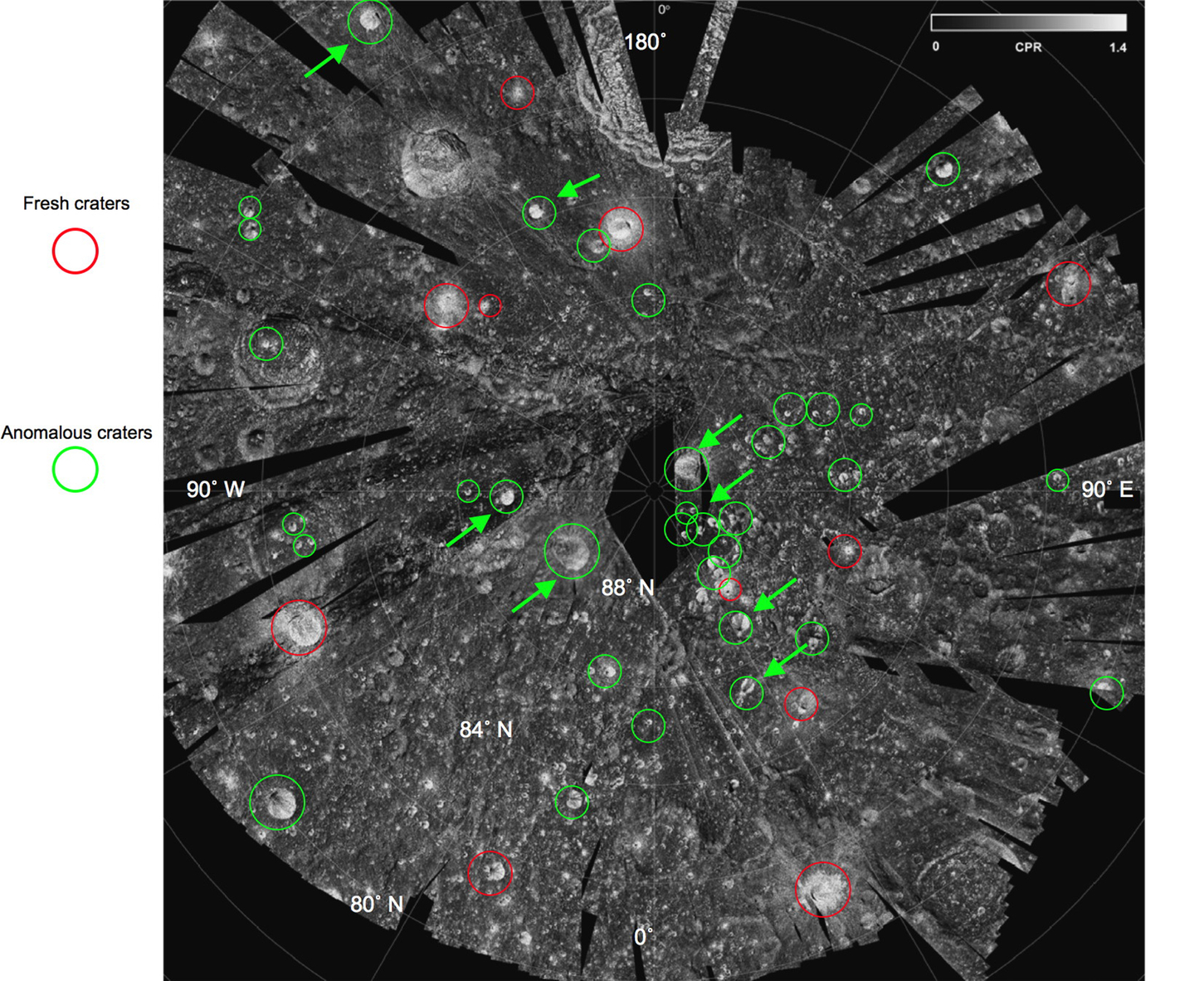
For example, another instrument aboard the Chandrayaan-1 spacecraft, the Moon Mineralogy Mapper (M3) also detected potential water on the lunar surface, in tandem with instruments on the Cassini and Deep Impact spacecraft. But this water was not found in permanently shadowed regions of the Moon. It has been suggested that the cold-trapped water at the poles is cometary in origin, but the water seen by M3 would need another source. There was speculation before the Apollo landings that hydrogen from the solar wind could interact with oxygen in silicates and create hydroxyl or water, but there was no evidence at that time. The M3 observations suggest that water on the moon may have different origins. More recently, radar and laser altimeter instruments onboard the Lunar Reconnaissance Orbiter have made measurements within permanently shadowed craters, and its camera has imaged within those areas using light scattered from crater walls. See Chapter 10 for more information about volatiles on airless bodies.
Lunar Impact History
Airless bodies give us an important window into the history of impacts throughout the solar system. Without aggressive weathering processes such as rain and wind, craters are preserved on timescales upward of millions of years. Thus, the impact records of airless bodies are a critical piece in understanding the origin and evolution of planetary surfaces across the solar system, impact dynamics, and the evolution of the impactor population through time. The Moon in particular is key, as this is the airless body from which we have actual ground truth to help tie down and calibrate absolute ages (see Chapters 4 and 5 for more information about how we determine ages, and how we associate ground truth and remote sensing). Calibrating the timing of the cratering record for the Moon is of the utmost concern in estimating the ages of all other cratered terrains.
In recent years, our ideas of the timing of the basin forming impacts on the Moon have been in flux, specifically theories about a “cataclysm” of impacts that might have been responsible for a major bombardment across the solar system 3.9 Ga ago. While the idea itself is not new (Tera et al., 1974), the hypothesis continues to be debated, and has spurred reexamination of dynamical models and impact melt breccia ages that are important for understanding the nature of airless bodies, with implications for all of solar system science.
As noted, in 1974 Tera inferred the possibility of “an event or series of events in a narrow time interval which can be identified with a cataclysmic impact rate of the Moon at ~ 3.9 Ga.” This was in response to two lines of data pointing to a major event or events happening at the same time: U-Pb ages in lunar anorthosites and the crystallization ages of impact melt breccias. The sets of ages both correspond to an interval between 3.75 and 3.95 Ga (Norman, 2009).
This has inspired two general hypotheses for the basin forming impact history of the Moon. The first is that the impact flux started high right after planet formation, as the solar system was filled with potential impactors left over from planetary accretion. These were quickly swept up, and then the impact flux dropped off steadily, reaching the levels we have today. This does not preclude minor episodes where the impact flux was somewhat higher perhaps created by the breakup of an asteroid or other source. However, in this model, the dropoff in impacts is a predictable decline. The apparent coincidence in ages is explained by “destruction or burial of older deposits by ejecta from more recent events such as those that formed Imbrium and Serenitatis, or by a sampling bias due to the small area actually included within the Apollo and Luna mission footprint” (Hartmann, 2003; Chapman et al., 2007; Norman, 2009).
The second hypothesis is that of the Terminal Lunar Cataclysm (TLC). In this scenario, the impact flux shows a steep increase at around 3.9 Ga corresponding to the creation of more than a dozen lunar impact basins. (While originally the term “Late Heavy Bombardment” was used specifically to refer to the final stages of accretion and basin forming in the first hypothesis, the steady-decline model, it is now confusingly used to refer to a cataclysm. When you hear this term, be certain what is being described.) In 2002, Ryder noted that such a cataclysm would require a huge amount of mass to be delivered to the moon, equal to 0.3% of the current mass of the entire asteroid belt.
One longstanding issue with the cataclysm hypothesis has been the problem of where a population of impactors might be stored for 500 Ma from the beginning of the solar system, waiting for the time to bombard the Moon around 3.9 Ga. However, the new dynamical models such as the Nice Model mentioned earlier open the possibility that the timing of giant planet migration might be able to explain an increase in impact rate near 3.9 Ga as well as the delivery of volatiles also mentioned earlier.
Still, the question that prompted the TLC remains: why are there so many basins that apparently formed at the same time? One possibility is that the formation of the Imbrium basin affected all earlier samples, and measurements that were thought to represent different basins are in effect repeatedly dating Imbrium. Future investigations and missions will need to target the ages of the older basins, specifically Nectaris, to discern which of these competing models is more accurate. As noted in Fig. 3.6, the age of Nectaris and the expected age curve has implications for other basins such as the ancient South Pole Aitken basin, which in turn will indicate whether the spread in basin ages suggests a cataclysm or gradual decline.
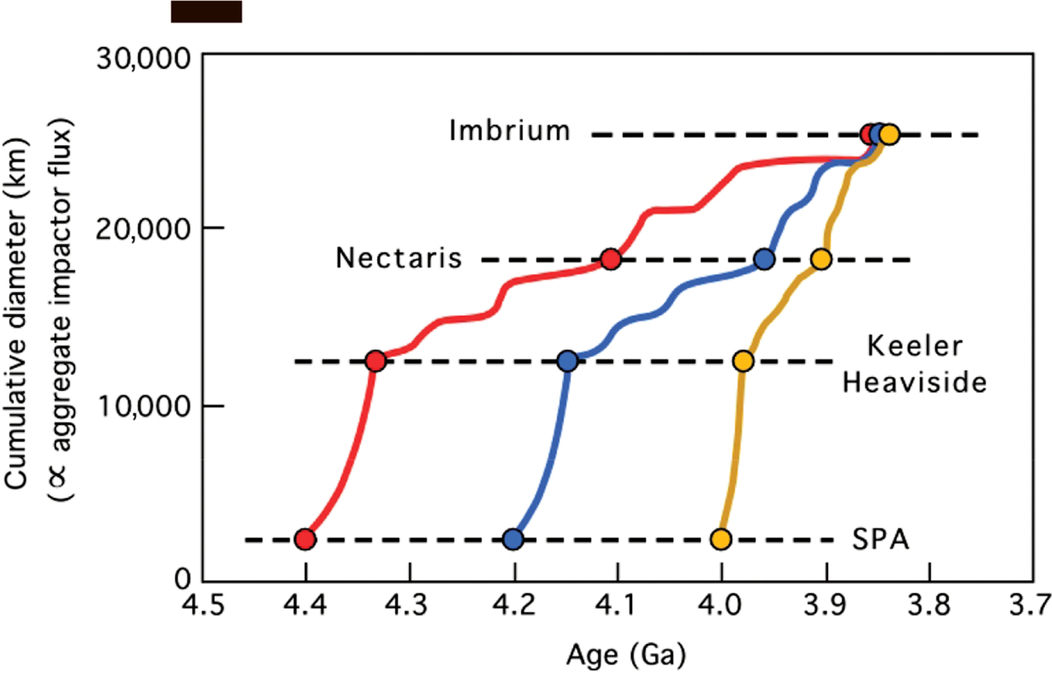
Mercury
After the Mariner 10 mission concluded, roughly 55% of Mercury's surface remained unmapped. However, the mission along with Earth-based radar and telescopic studies had established several key properties of the planet and its surface: its reflectance spectrum in the visible-near IR was featureless and its average albedo was lower than the Moon’s. This left its composition effectively unknown. Mariner images showed it at least superficially resembled the Moon in terms of craters and basins. Finally, unlike the Moon, it had a significant magnetic field and a large iron core. Despite these differences from the Moon, the pre-MESSENGER view of Mercury was one of a very lunar-like body, with their differing surface properties thought perhaps due to their very different locations relative to the Sun and the resulting variation in the relative importance of space-weathering processes (Fig. 3.7).
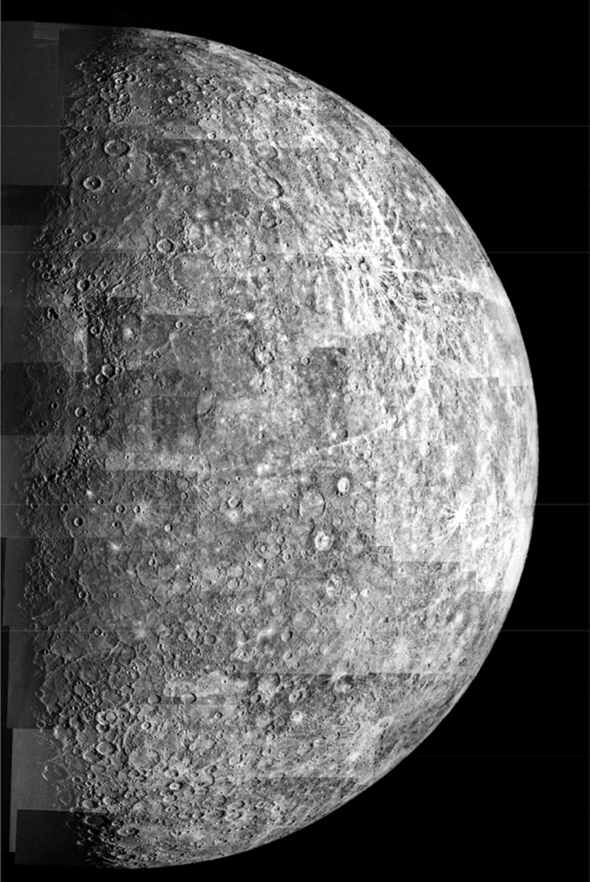
Volatiles on Mercury
The same arguments that led researchers to search for volatiles on the Moon also led them to search for water on Mercury, and some of the techniques used to find ice on the Moon also found ice on that planet in amounts much larger than seen on the Moon. The earliest evidence came from radar studies of Mercury, which found material with high radar reflectivity near the Mercurian poles, as in the lunar case. It is suspected that the same processes may be in action here, with cometary or other delivered water being protected in permanently shadowed regions and allowed to persist by low temperatures. Details of the detection of ice on Mercury by MESSENGER and by radar data are presented in Chapter 10.
The MESSENGER mission also found unusual features named “hollows,” which appear related to loss of volatiles. These depressions are found most often on slopes that face the equator (see Chapter 10), as one might expect if they were related to heating from the sun. Such solar heating may allow for a loss of volatiles, and space weathering may contribute as well to the formation of the depressions. See Chapter 10 for more details about volatiles on Mercury and discussions of hollows, and more general comparisons to the Moon.
Surface Composition
After Mariner 10, most people assumed the Moon and Mercury were very similar. The featureless spectrum of Mercury was interpreted to be like very mature lunar soils, which are also spectrally featureless. However, Mariner 10 had limited instrumentation and Mercury's high temperature can interfere with some measurements: Mercury's own radiated heat overwhelms reflected light at much shorter wavelengths than other airless objects and limits the utility of reflectance spectroscopy (Chapter 4). What spectra existed suggested very little oxidized iron was present.
MESSENGER has allowed for a revolution in our understanding of the basic composition of the Mercurian surface, and how that surface changes with processes such as space weathering. Multispectral imaging with 8 filters from 430 to 1000 nm at sub-km spatial resolutions and spectroscopy from 300 to 1450 nm at ~ 5-km scales (and 10-km-scale UV spectroscopy) in addition to an X-ray and gamma ray spectrometer meant that elemental compositions could be directly measured and compared to any mineralogical features that could be spectrally identified. The combined results indicated an iron-poor (abundance 2% or less) surface, but imaging instruments were able to identify four major spectral units on the planet's surface that differ from one another in spectral slope and albedo. Very recent work suggests that carbon may be present in significant concentrations, which could explain aspects of Mercury's featureless spectrum and variation between areas.
The lack of iron in Mercurian surface minerals leads them to react to micrometeorites and solar wind differently from lunar minerals, which are iron-rich relative to what is found on Mercury. Chapter 6 discusses space weathering on airless body surfaces, though understanding how it affects the surface of Mercury is the subject of ongoing research.
Mercury is also unique among the objects discussed in this book because it has a strong magnetic field, thought to require a still-molten iron core. The planet's density is second only to Earth’s, and calculations removing the effect of gravity show that Mercury is inherently denser than any other planet. These facts indicate a high iron content, even if very little is apparently found near the surface. As we will discuss in Chapter 5, it is expected that the bulk of relatively dense materials like iron will find their way to the core of a differentiated body. However, typically some iron still remains on and near the surface, depending on conditions. For instance, the Earth has a large iron/nickel core but still retains plenty of iron in its crust for industries such as mining and manufacturing. Part of the story of the reduced abundance of iron on Mercury's surface may relate to the presence of carbon.
Vander Kaaden et al. (2017) performed geochemical experiments on the composition of Mercury's core, finding that if Mercury's core is sufficiently rich in silicon, carbon would be forced out of the core where it might otherwise reside. The result is that carbon would have largely been excluded from both the metallic core and more silicate mantle, leading to relatively low-density graphite floating upwards. We might therefore expect surface materials on Mercury to be enhanced in carbon graphite even after extensive mixing through volcanic and impact processes, consistent with the presence of the dark, low-reflectance areas seen on the planet (Peplowski et al. 2016).
Phobos and Deimos
The state of knowledge of Phobos and Deimos was still quite murky at the turn of the century. Imagery from the Viking and Phobos 2 missions provided coverage of both satellites, though the coverage and resolution available for Phobos was better than for Deimos. Both objects were known to have large impact craters, with the Stickney crater dominating Phobos’ Mars-facing hemisphere and enigmatic linear fractures called “grooves” also present on its surface (but not Deimos’ surface), discussed in more detail in Chapter 11. Both were known to have low albedos and general spectral properties consistent with outer-belt asteroids, which led to interpretations that they were captured early in Mars’ history and expectations that they would have water- or hydroxyl-bearing minerals and perhaps ice in their interiors. More detailed spectral observations from Phobos 2 showed that Phobos also had a region near the rim of Stickney crater that was not as red as the rest of the object. Given what was known about other airless bodies, this led to speculation that this less-red region was freshly exposed in association with the Stickney impact and would eventually mature to the level seen on the rest of Phobos. However, the origin of Phobos and Deimos as captured objects was difficult to reconcile with dynamical models that found that capture and evolution into their current orbits was extremely unlikely. The other main theory for the origin of the Martian satellites proposed that they are leftover debris from a giant impact into Mars, perhaps with Phobos and Deimos the last representatives of a once-larger population of Martian satellites. The predicted compositions for satellites derived from a giant impact onto Mars did not seem to match the measured spectra of Phobos and Deimos, however. Telescopic observations of Phobos and Deimos are difficult given their proximity to Mars, which is a large source of scattered light. However, some telescopic measurements were successfully made, showing little or no evidence for hydrated minerals on Deimos or in either the more-red or less-red parts of Phobos.
While there have not yet been successful spacecraft dedicated primarily to the study of Phobos and Deimos, the continuing exploration of Mars by many nations has led to some new datasets for its satellites. The major advance has been provided by the infrared spectrometers on the Mars Express (MEx) and Mars Reconnaissance Orbiter (MRO) missions, which have provided improved spectral coverage and resolution and better-quality data than was previously available. Interpretation of these data shows weak absorption bands on Deimos and the redder unit of Phobos near 0.7 μm that are indicative of hydrated minerals, though a cause by nanophase iron has not been ruled out. This weak band is not seen in the less-red unit of Phobos, casting doubt on the interpretation of a weathering relationship between the less-red and redder units. In addition to this weak band, absorptions are seen at 2.8 μm on Phobos and Deimos that are due to hydroxyl. It is not yet clear whether this absorption is due to material native to the martian satellites or if it was created by solar wind interactions with silicates, like interpretations of similar absorptions on the Moon discussed earlier. Imagery of Phobos from MEx and MRO provides improved spatial resolution compared to earlier missions, though the anti-Mars hemisphere of Deimos remains very poorly imaged. The coming decade promises to bring much more clarity to our understanding of the martian moons, as the Japanese plan a sample return from Phobos, discussed in Chapter 12 along with other future mission plans (Fig. 3.8).
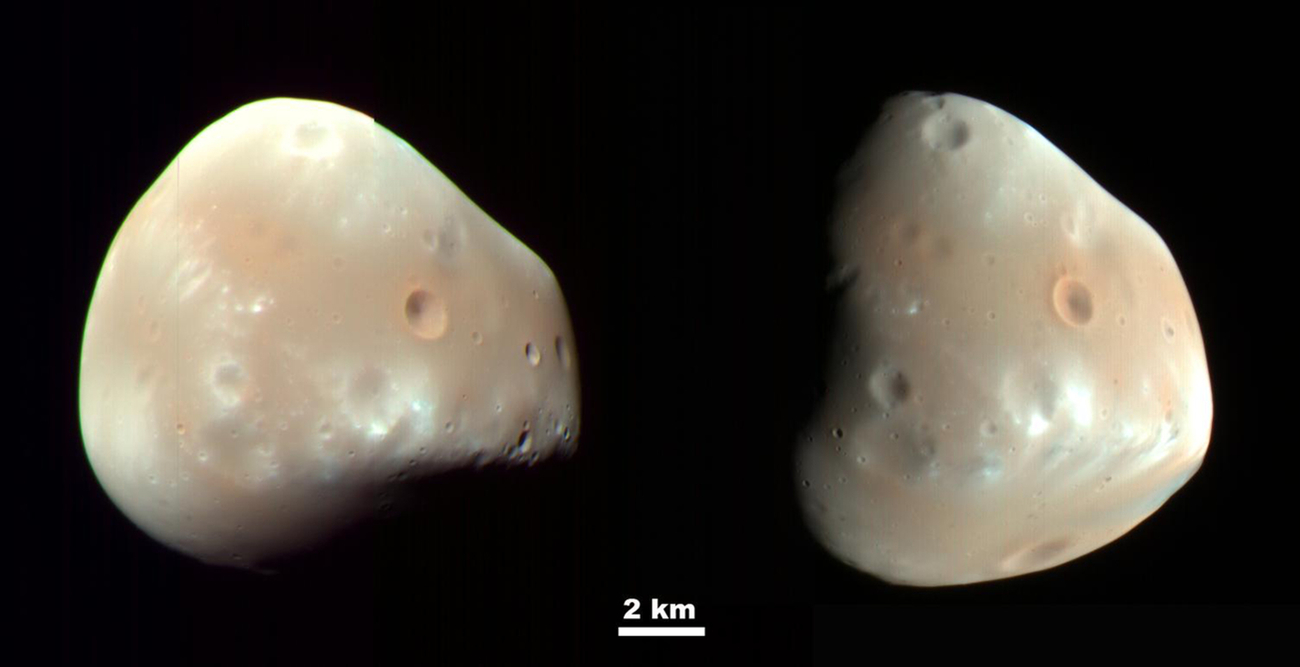
The Asteroids
Around the year 2000, our understanding of asteroids and their surfaces was rudimentary but evolving. As noted earlier, the Galileo encounters with Gaspra and Ida found spectral differences across their surfaces that were consistent with lunar-style space weathering. Galileo's discovery of Ida's satellite Dactyl led to the realization that asteroidal satellites could be more common than previously expected, and subsequent Earth-based radar and telescopic studies detected satellites around ~ 10%–15% of the objects they studied, with strong correlations between the probability an object would have a satellite and its size. A variety of shapes of reflectance spectra were seen in the asteroidal population, and classification schemes were generated to organize and compare the different shapes (see Chapters 4 and 5). Many spectral groups were consistent with what was seen in meteorite spectra, but the links were still subject to some doubt. The Galileo images showed that Ida and Gaspra were covered in regolith, but it was expected that smaller asteroids would be bare rock, with gravity unable to hold the impact-generated debris that made up regolith. The discovery of craters on Ida and Gaspra was expected, and linear structures like the grooves of Phobos were attributed to fractures from large impacts. Chapter 11 discusses grooves on airless bodies in much more detail.
The close-up study of (433) Eros, (25143) Itokawa, Vesta, and Ceres, as well as continued telescopic study of the asteroids, more distant and/or limited spacecraft study of 2867 Šteins, (21) Lutetia, (4179) Toutatis and other asteroids, and advances in theoretical and computational modeling, have changed our conception of these bodies in fundamental ways (Figs. 3.9 and 3.10). The NEAR Shoemaker mission found enigmatic areas of fine-grained regolith in gravitational lows (usually the floors of craters) on Eros, which were termed “ponds” or “ponded deposits.” These were attributed to motion of regolith from other areas on Eros, or perhaps due to mass wasting after impacts on distant parts of Eros. More recent studies suggest that the ponds may come from the disaggregation of large blocks after untold heat/cool cycles. Images of Itokawa from Hayabusa demonstrated that object was effectively a 300-m collection of blocks of all sizes held together by self-gravity rather than a single large boulder devoid of regolith, a “rubble pile” configuration. Itokawa's appearance is very different from other asteroids that have been visited, though we do not yet know whether it is typical of sub-km scale asteroids.
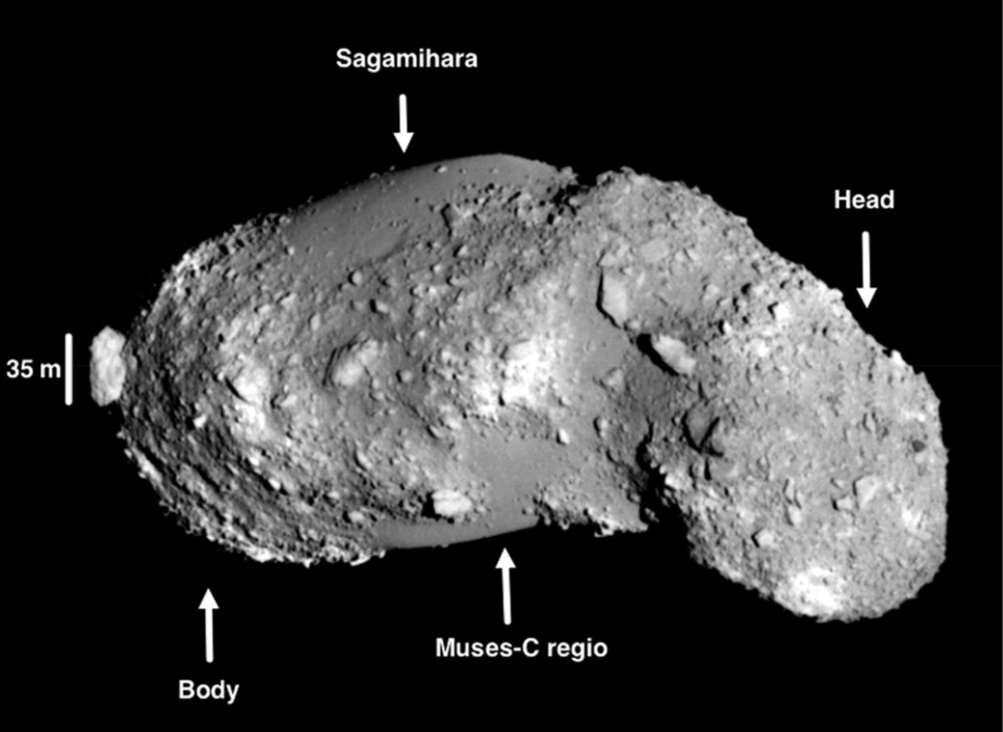
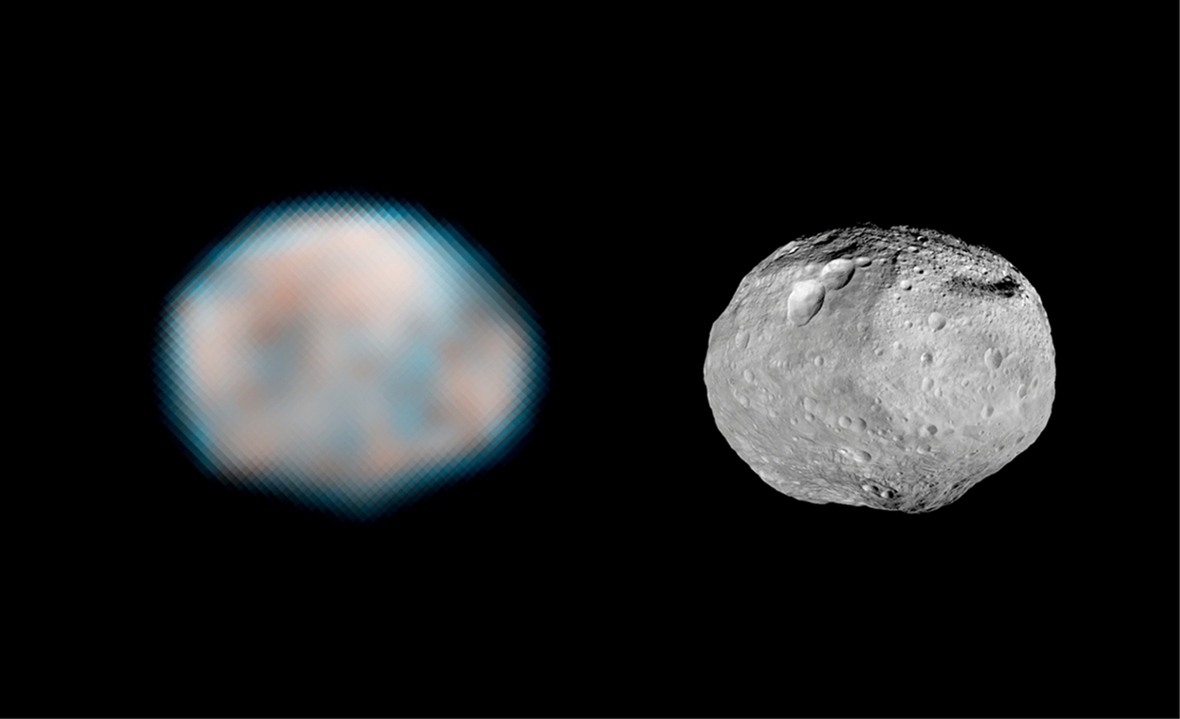
The importance of nongravitational forces and of processes other than impact cratering has also been recognized in the past decade. The YORP force is now favored in theories of asteroid satellite formation and has been implicated in mass transport across asteroidal surfaces (Chapter 11). Cohesion due to van der Waals forces is thought to be important in microgravity like what is experienced on small bodies, and may allow rubble piles to remain together at spin rates where gravity would otherwise be unable to keep them bound. Measurements of small objects impacting the Earth's atmosphere are also consistent with this view, highlighted by the asteroid 2008 TC3. This roughly 2-m object impacted in northern Africa a few days after its discovery, and pieces were recovered as the meteorite Almahatta Sitta. Observations of 2008 TC3 showed that it was rotating with a period of only a few minutes, but the recovered pieces of Almahatta Sitta included mostly gravel-sized rocks. This leads to the conclusion that 2008 TC3 spent some time in space as an object a few meters across, made of gravel-sized chunks, and rotating very quickly. Cohesion must have been important in its remaining a single object. Furthermore, compositional studies show different pieces of Almahatta Sitta must have formed on very different parent bodies, and some of the individual pieces of gravel may only have been mixed with the rest of the gravel at a relatively late stage.
Compositional studies of asteroids were revolutionized by the samples returned by Hayabusa. While the particles returned were typically ~ 10 μm in size, it was shown that Itokawa had the same composition as the LL group of ordinary chondrites. This established that the ordinary chondrites, the most common meteorites to fall to Earth, are linked to the S-class asteroids, the most common near-Earth asteroids, and ended a decades-long controversy. Another asteroid-meteorite link was more firmly established by the Dawn spacecraft during its visit to Vesta. While Dawn did not sample Vesta, its gamma-ray and neutron spectrometer determined the elemental composition of Vesta and found it to be consistent with the HED group of meteorites. This group had been linked to Vesta through spectral evidence as well as other arguments, but the Dawn data provided another independent link. Dawn also found evidence of hydrated minerals on Vesta via its neutron detector and its infrared spectrometer. The existence of hydrated minerals on this object, once thought like the Moon to be among the most volatile-poor objects in the Solar System, has led to a re-examination of infall and impactor contamination as a possible delivery mechanism of hydrated minerals to asteroids in general. Following its visit to Vesta, Dawn traveled to Ceres, where it continues to orbit today. Dawn has returned data showing Ceres to be a world that straddles the boundary between rocky and icy objects, with abundant volatiles (Chapter 10) and surface features that suggest recent or ongoing cryovolcanism (Chapter 11). The question of how unique Ceres is among large asteroids is an open question, and it seems possible that other objects in the asteroid belt may share its partly rocky, partly icy nature.
Models of collisional evolution of the asteroids show that disruption, an extreme version of impact cratering, has been an important and ongoing process on asteroids. It is thought that objects smaller than roughly 50-km diameter were once part of larger objects that later disrupted, while objects larger than roughly 200-km diameter are large enough that disruption is exceedingly rare and so they are expected to have always been intact, as noted earlier. Objects intermediate in size may have been disrupted and reaccumulated, or may be intact. This leads to the idea that very large asteroids like Vesta and Ceres may have had different histories than asteroids like Eros, Gaspra, and Ida in a qualitative sense—the latter objects may be composed of material that once resided in the interior of a larger body, while we are reasonably confident that most of the present-day surface of Vesta has always been at or near its surface. Apart from this implication, it is also certainly the case that some processes that are very effective at smaller masses are inefficient or absent on larger asteroids.
Summary
A wealth of new data in the last decade from spacecraft and telescopes has led planetary scientists to reconsider many of their thoughts about rocky airless bodies. The first wave of missions and observations relied upon analogies (asteroids are like Phobos and Deimos; Mercury is like the Moon) and imagined a set of geologically static objects orbiting endlessly unchanging, save for relatively rarely suffering impacts. The new measurements and observations, combined with the availability of more sophisticated simulations of orbital dynamics and surface evolution, show instead that these analogies are not as strong as once thought or are superficial—there is a wide variety in small body compositions and geology; Mercury is far from being a twin of the Moon. Furthermore, their histories are full of active processes, from gravitational and nongravitational forces drastically changing asteroidal orbits and spins to the unceasing rain of solar wind protons changing surface spectral properties to volatiles hopping across their surfaces before finding a cold place to stick. The following chapters will address many of these processes in additional detail.